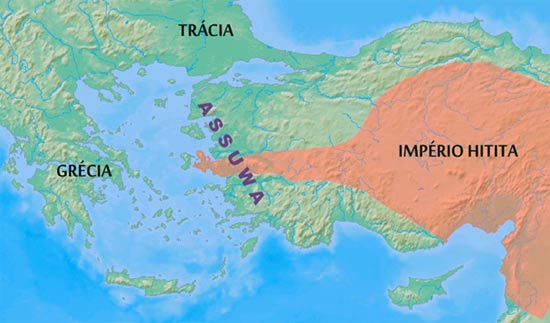
In Search of Helen of Troy
Her face was the face that launched a thousand ships. Considered to have been the most beautiful woman in the world, Helen would be seduced by the Trojan prince, Paris and travel to his homeland of Troy. She would leave behind her Spartan homeland and her husband, Menelaus. Enraged, Menelaus would convince his brother, Agamemnon, to set sail for Troy and to retrieve his wife. A war ensued and lasted for ten years. At least, that is how the Trojan Cycle depicts these events. Did a Helen, or a historical representation of Helen exist at some point during the Late Bronze Age of the Eastern Mediterranean (ca. 1500 - 1200 BCE)? Was a war waged between two power nations over a woman? A re-reading of a historical document may lead to some answers.
To the East of Troy ruled the Hittite empire over most of Anatolia, centered at Hattusa, near modern day Boğazkale (formerly, Boğazköy), Turkey. Discovered within the ruins of the mighty Hittite citadel were piles of baked tablets. Each was written in a cuneiform script, but in what was at the time an undeciphered language, until scholars in the mid-20th Century CE uncovered the Hittite language to be that of an early Indo-European type (Macqueen, 24). With its code cracked, these tablets would rewrite the history of the Late Bronze Age. Written within the translated texts were activities and negotiations between two world powers, the Hittites and the Ahhiyawa. At first the origin of these Ahhiyawa puzzled scholars but before long, they were to be identified as Homer’s Achaeans, or the Mycenaean Greeks. From the 15th century BCE to as late as the 12th century BCE, the Mycenaeans were involved in assorted activities all along the Western Anatolian coast, both for and in opposition to the Hittite empire; some of which involve the Hittite vassal province of Wilusa, that is, Ilios (Troy). These tablets have also illuminated a cast of characters which would later be reflected in the Homeric epic, such as Atreus, Alexandros (another name for Paris), and even a possible rendering of Priam.

The Mycenaean dominion is highlighted in purple and the Hittite in blue. (Wikipedia)
A curious Hittite document may hold some clues as to what would inspire the story of Helen. It is referred to as tablet CTH 183. Written in the Hittite language and utilizing the cuneiform script, this letter was commissioned by the Mycenaean Greek king and sent to the Hittite king, most likely Muwatalli II (reigned ca. 1295–1272 BCE). Although being somewhat damaged, what has been deciphered is a dispute between the Mycenaean and Hittite monarchs over the rightful ownership of a group of islands off of the Anatolian coast that had formed a part of a dowry in a previous generation. This is where it gets interesting. It was the then Mycenaean king who mentions his great grandfather, wa-ka-ga-mu-na-aš (sometimes rendered Kagamuna). Could this be a rendering of the infamous Agamemnon, son of Atreus? The letter continues to mention that the Hittite king’s great-grandfather, Tudhaliya, after defeating and subjugating the rebellious Assuwa lands (an ancient name for Asia) (ca. 1400 BCE), had given the lands in question to the Mycenaean king as part of a diplomatic marriage to an Assuwan princess.

Map depicting Assuwa (Wikipedia)
It is plausible that this unknown Assuwan princess is the prototype for Homer’s Helen, upon which countless legends have since been told. If this is the case, could the reason for a Trojan-type war have been the result of disputes over land ownership in Western Anatolia? Could this Kagamuna be Homer’s Agamemnon? The ancient Hittite document certainly provides food for a thought, and will hopefully form the basis for more extensive research in the future.
Featured image: Menelaus intends to strike Helen; struck by her beauty, he drops his swords. A flying Eros and Aphrodite (on the left) watch the scene. Detail of an Attic red-figure crater, ca. 450–440 BC, found in Gnathia (now Egnazia, Italy). (Wikipedia)
Sources
Beckman, Gary. Trevor R. Bryce. Eric H. Cline. The Ahhiyawa Texts. Atlanta: Society of Biblical Literature, 2011. [Print]
Macqueen, J.G. The Hittites: And their Contemporaries in Asia Minor. 2nd ed. New York: Thames & Hudson, 2003. [Print]
















Comments
Angie,
Thank you for sharing your thoughts. I too want these stories to be true. :-D
--
Petros Koutoupis
www.petroskoutoupis.com
That's a very interesting possibility! In a way I really want the story to be true, because it's a great story! But having the facts of what actually happened also seems like they would make for a pretty good story too!
love, light and blessings
AB
That's a pretty interesting concept, but I do believe more evidence is required.
Peace and Love,
Ricky.